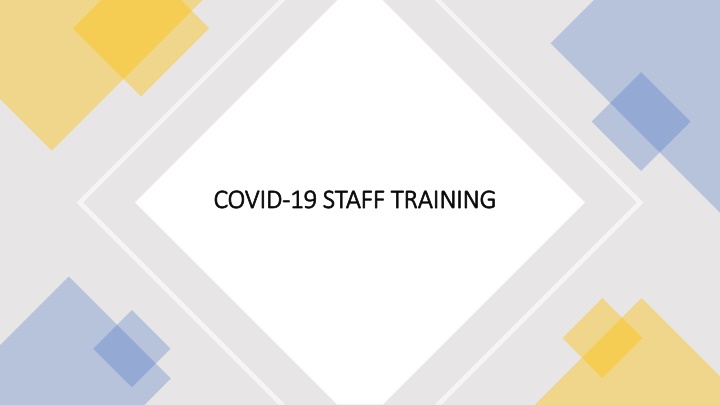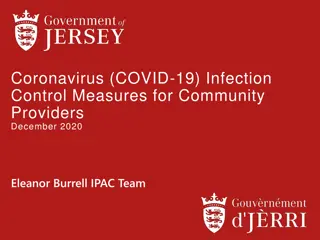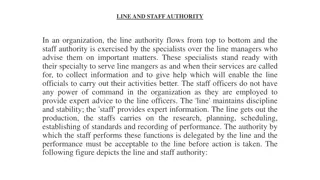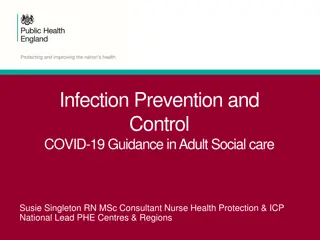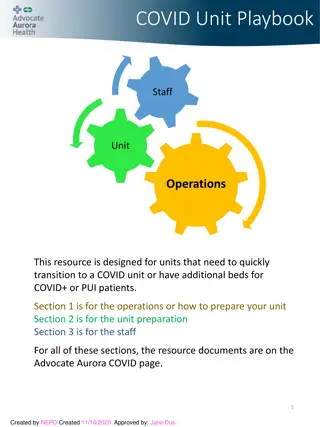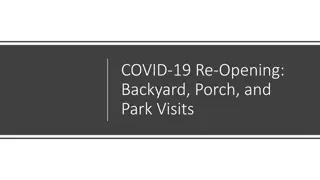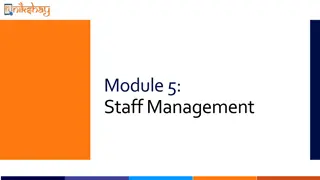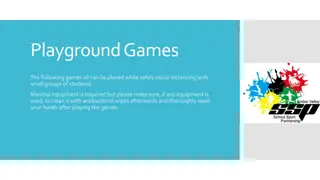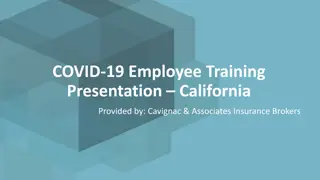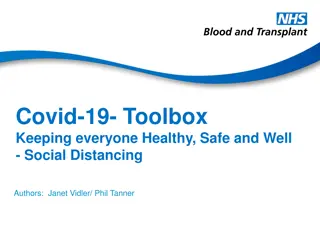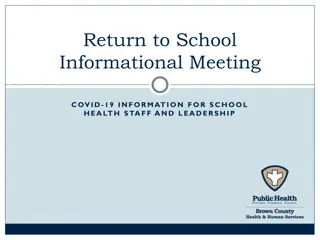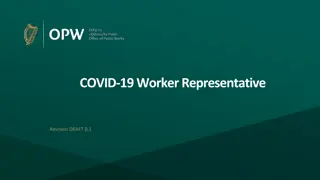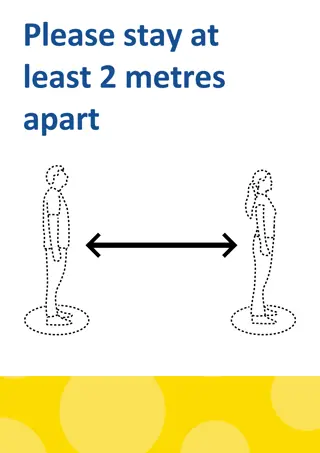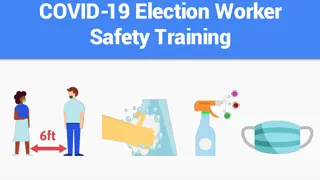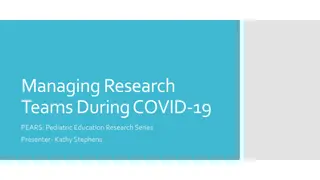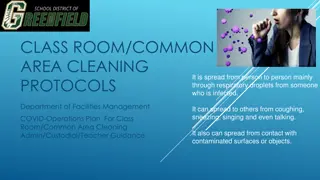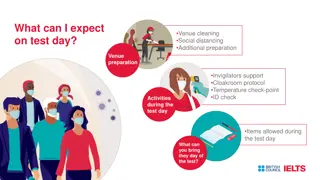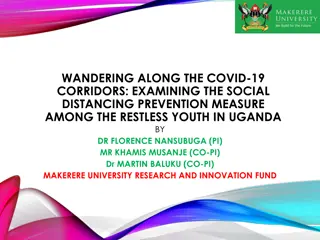Importance of Physical Distancing and Basic Training Elements for COVID-19 Staff Training
Physical distancing plays a crucial role in preventing the spread of COVID-19, both at work and outside of work hours. This article emphasizes the significance of monitoring symptoms, staying home when sick, proper hygiene practices, wearing masks, and disinfection protocols. It also highlights the importance of social distancing and behavioral practices in the workplace to reduce the risk of transmission. The content provides valuable information on identifying high-risk populations, self-monitoring for symptoms, and steps to take if exposed to the virus.
Download Presentation

Please find below an Image/Link to download the presentation.
The content on the website is provided AS IS for your information and personal use only. It may not be sold, licensed, or shared on other websites without obtaining consent from the author.If you encounter any issues during the download, it is possible that the publisher has removed the file from their server.
You are allowed to download the files provided on this website for personal or commercial use, subject to the condition that they are used lawfully. All files are the property of their respective owners.
The content on the website is provided AS IS for your information and personal use only. It may not be sold, licensed, or shared on other websites without obtaining consent from the author.
E N D
Presentation Transcript
COVID COVID- -19 STAFF TRAINING 19 STAFF TRAINING
What is the importance of physical distancing, both at work and off work What is the importance of physical distancing, both at work and off work time? time? The more an individual interacts with others, and the longer that interaction, the higher the risk of COVID-19 spread. 1 This video shows an example of how communicable diseases such as COVID- 19 can spread out quickly within a restaurant, then it reflects the importance of the Social Distancing Protocol both at work and outside work. https://www.youtube.com/watch?v=kGQEuuv9R6E
Basic Training Elements Basic Training Elements 1. Monitor for symptoms (fever or chills, cough, shortness of breath or difficulty breathing, fatigue, muscle or body aches, headache, new loss of taste or smell, sore throat, congestion or runny nose, nausea or vomiting, diarrhea, etc.) Stay home if you are sick, have tested positive for or are showing COVID-19 symptoms Employees who live with a person diagnosed with COVID-19 shall also stay home and monitor their health Proper hygiene and handwash (warm water 100F and soap/20 sec) Proper ways to wear a face mask (cover nose and mouth, wash hands before & after touch face mask) Employees shall know criteria of return to work if they have been sick with COVID-19 Disinfection after excluding staff diagnosed with Covid-19 Identify High Risk Population and options to keep them safe Prevention measures review 10. Frequent disinfection process of breakrooms, bathrooms, common areas and commonly touched objects such as pens, PIN pads, cash registers, door handles, etc. 2. 3. 4. 5. 6. 7. 8. 9.
Monitor for symptoms Monitor for symptoms Here is a video to self-monitor for symptoms https://www.youtube.com/watch?v=DeTPOsTb1C8 Stay at home if sick (fever or chills, cough, shortness of breath or difficulty breathing, fatigue, muscle or body aches, headache, new loss of taste or smell, sore throat, congestion or runny nose, nausea or vomiting, diarrhea, etc.) Stay at home and monitor for symptoms if someone you live with have been diagnosed with COVID-19. Seek medical attention if their symptoms become severe, including persistent pain or pressure in the chest, confusion, or bluish lips or face.
Social distancing and behavior at work Social distancing and behavior at work Be diligent: You must continuously monitor your health before and during food service. Anyone reporting shortness of breath, coughing or two of the following symptoms must stay or be sent home and asked to speak to their physician: Fever, chills, repeated shaking with chills, muscle pain, headache, sore throat and new loss of taste or smell. Wear a face cover at work. Keep a 6 feet distance from others. Pay special attention to those in close contact while at work. Stay alert and avoid interactions longer than 15 minutes. Always be aware and identify close contacts (workers near you within six feet for 15 minutes or more) this is useful because if an employee is diagnosed with COVID-19 will facilitate the isolation and identification of close contacts as is required.
What to expect if a person working in a food facility is diagnosed with What to expect if a person working in a food facility is diagnosed with Covid Covid- -19 19 If a person with constant contact with others in the business is COVID-19 positive, the facility will be contacted by the Santa Cruz County Communicable Disease Unit to discuss interactions within the business. The Environmental Health Division may follow-up with the facility depending on the results of the investigation. There are HIPAA protections that restrict sharing of personal medical information. You cannot be forced to provide this information, but you are free to volunteer this for the safety of others. You won't get in trouble for reporting this information. Food service is essential, reopen of service can be done after exclusion of all individuals with symptoms, and disinfection of the facility. All reports related to sick people shall be taken seriously and conducted with diligence by investigating the allegation and checking in with all other staff to ensure that people are healthy while at work.
When do I need to stay at home and when can I return to work? When do I need to stay at home and when can I return to work? Stay home if tested Positive or with symptoms of Covid-19 or if someone at home is Covid-19 positive. COVID-19 Positive Individuals & Individuals with Symptoms but No Testing These individuals must remain in isolation until the following is met: 1. No fever for 72 hours (3 days) without use of fever-reducing medication; 2. Other symptoms have improved (cough, or shortness of breath, etc.); and 3. At least 10 days have passed since symptoms first appeared COVID-19 Positive with No Symptoms These individuals must remain in isolation until the following is met: 1. At least 10 days have passed since the date of their first positive COVID-19 diagnostic test and 2. They remain asymptomatic
Individuals: o In close contact with COVID-19, o No confirmed COVID-19 and no symptoms and o No close contact with the ill people and no symptoms Can continue with essential work provided: they are screened daily and continue to have no symptoms practice proper handwashing and sneeze/ sporadic cough etiquette, respect social distancing protocols and follow surfaces are disinfected frequently.
Proper Hygiene Proper Hygiene Prevent Food Contamination Measures to prevent contamination: Washing hands between changes in activity including handling money Minimizing bare hand contact with ready to eat food Removing any non-essential individuals in the food service area Preventing non-service animals from entering the facility Avoiding using cups or containers provided by the public for now Sneezing away from food and into an area that will prevent spreading of aerosol droplets like an elbow Proper sneezing procedure can help protect others from colds, flu and COVID-19.
Proper Handwash rule of the 20 seconds Proper Handwash rule of the 20 seconds Here you can see a video how handwashing for 20 seconds can inactivate the virus effectively https://www.youtube.com/watch?v=- LKVUarhtvE Handwashing supplies must always be present, functional and equipped during service. A person must oversee and make sure these remain usable and stocked while preparing food and conducting clean-up activities. We recommend use of alcohol-based (at least 60% Ethanol or 70% Isopropyl) hand sanitizer after handwashing. Hand sanitizer shall not be used in lieu of handwashing. Gloves must be changed at a frequency required for handwashing. Staff shall wash their hands before putting on and upon changing gloves. Food service staff shall wash their hands under, but not limited to, the following conditions: When entering the kitchen and before starting food preparation After touching the face, hair, and other areas of the body After using the restroom Between handling raw meat and ready to eat foods After sneezing, coughing, or using a tissue After smoking, eating, drinking and using a phone After cleaning tables, bussing, handling dirty dishes, and touching items in contact with patrons When hands become soiled Provide a garbage can near the restroom exit door so that staff can dispose of paper towels used to open the door.
Proper ways to wear a face coverings Proper ways to wear a face coverings Effective April 25, 2020, all essential food workers and patrons visiting food service facilities must wear face coverings to prevent exposure from asymptomatic individuals. Here is a video of how to wear a face mask properly https://www.youtube.com/watch?v=fqPFroF9k6Y&feature=youtu.be Remember: Face coverings can help protect people near the wearer, but do not replace the need for physical distancing and frequent handwashing. Employees shall wash or sanitize hands before and after using or adjusting face coverings. Avoid touching the eyes, nose, and mouth. Face coverings shall be washed after each shift. Avoid share any object or food with other staff member. This video shows The Do s and Don ts of Wearing Masks and Gloves https://www.youtube.com/watch?v=eVJbenwzR1s
High Risk Population High Risk Population People 65 years and older People of all ages with underlying medical conditions, particularly if not well controlled, including: People with chronic lung disease or moderate to severe asthma People who have serious heart conditions People who are immunocompromised including cancer treatment, smoking, bone marrow or organ transplantation, immune deficiencies, poorly controlled HIV or AIDS, and prolonged use of corticosteroids and other immune weakening medications People with severe obesity (body mass index [BMI] of 40 or higher) People with diabetes People with chronic kidney disease undergoing dialysis People with liver disease Here is a high-risk population video with recommendations https://www.youtube.com/watch?v=qb7shu_sdQ0&feature=youtu.be
Taking care of High Taking care of High- -Risk employees Risk employees Offer options for employees at higher risk for severe illness (including older adults and people of all ages with certain underlying medical conditions) that limits their exposure risk (e.g., modified job responsibilities such as managing inventory rather than working as a cashier or managing administrative needs through telework). Consistent with applicable law, develop policies to protect the privacy of persons at higher risk for severe illness in accordance with applicable privacy and confidentiality laws and regulations.
Prevention measures review Prevention measures review It is critical that food service workers or volunteers be screened for symptoms of illness prior to being allowed to commence food service work. Now you can identify conditions or illnesses that would exclude you from food service and you know when to stay home. It is not a good idea to come in to work when you are ill. Individuals with fever, cough, or difficulty breathing must be excluded due to the risk of COVID- 19. Individuals with symptoms of other illness like diarrhea, vomit, nausea, nose drip and any illnesses communicable by food must also be excluded as is currently required under California Retail Food Code regulations. In addition to knowing when to stay home, staff must have working knowledge regarding processes needed keep food safe. Training must be provided based on their assigned duties before being allowed to work on their own. All workers must wear a face cover while at work unless they have a doctor s note noting they cannot wear a face cover due to an underlying condition. Keep your distance in any office areas, kitchens, pantries, walk-in freezers, or other high-density, high-traffic employee areas like bathrooms, hallways, bar areas, reservation and credit card terminals, etc. Food preparation employees shall avoid changing or entering others workstations during shifts.
Disinfection Disinfection Disinfection is the act eliminating a specific agent from a surface- in this case COVID- 19. Disinfection must occur using a chemical or method approved by the EPA to disable the COVID-19 virus. Chlorine (also known as bleach) can be used. Use 1/3 cup of bleach per gallon of water to disinfect surfaces and properly disable the virus. Note: This is more than what is regularly required to sanitize food service equipment. The facility must be thoroughly sanitized and disinfected after exclusion of sick employees with COVID-19. The facility will be contacted by the Environmental Health Department for instructions before re-opening. It is highly recommended that the disinfection process is performed by a reputable third-party cleaning service.
Cleaning and Disinfection must be done according to the plan Identify your Cleaning and Disinfection must be done according to the plan Identify your critical areas and follow through critical areas and follow through Examples of high traffic areas, such as customer waiting areas and lobbies, break rooms, lunch areas and areas of ingress and egress including host stands, entry ways, stairways, stairwells, escalators, handrails, and elevator controls. Examples of commonly used surfaces include doors, door handles, crash bars, light switches, waiting area chairs, credit card terminals, ATM PIN pads, receipt trays, bus tubs, serving trays, water pitcher handles, phones, toilets, and handwashing facilities. All touchable surfaces identified at kitchen area must be disinfected between shifts or between users, whichever is more frequent, including but not limited to working surfaces, phones, registers, touchpads/touchscreens, tablets, timeclocks, appliances, kitchen and bar utensils and implements, oven & refrigerator doors, grill and range knobs, carts and trolleys, keys, etc.
Cleaning and Disinfection must be done according to the plan Identify your Cleaning and Disinfection must be done according to the plan Identify your critical areas and follow through critical areas and follow through Thoroughly clean each customer dining location after every use. This will include disinfecting tables, chairs, booster seats, highchairs, booths, etc. and allowing adequate time for proper disinfection, following product instructions. Many EPA- approved disinfectants require minimal contact time (seconds to one minute) against human coronavirus. Reusable customer items including utensils, food ware, breadbaskets, etc., must be properly washed, rinsed, and sanitized. Cleaned flatware, stemware, dishware, etc., must be properly stored away from customers and personnel until ready for use. Employees must wash hands before pre-rolling utensils in napkins. The pre-roll should then be stored in a clean container. After customers are seated, the pre-roll should be put on the table by an employee who recently washed their hands. Make sure to handle utensils and other items to the customer with washed hands.
Why is important offer outside seating. Outdoor vs. Indoor Why is important offer outside seating. Outdoor vs. Indoor This video explain how coronavirus spreads outdoors vs. indoors https://www.youtube.com/watch?v=n6QwnzbRUyA&feature=youtu.be 1. Prioritize outside seating. 2. Open doors and windows (screen present) to promote indoor ventilation.
SOURCES SOURCES 1. Federal/ CDC Guidelines. Retrieved May 29, 2020 from: https://www.cdc.gov/coronavirus/2019- ncov/community/organizations/business-employers/bars-restaurants.html 2. Dine in Food Service Guidelines from the State of California. Retrieved May 29, 2020 from: https://covid19.ca.gov/pdf/guidance-dine-in-restaurants.pdf 3. Internal guidelines COVID-19 Information for Food Facility Operators Retrieved May 29, 2020 from: http://scceh.com/Home/Programs/ConsumerProtectionPrograms/FoodFacilityInformation/COVID- 19InformationforFoodFacilityOperators.aspx
Videos Sources Videos Sources NowThis News. 2020, May 12. Black light experiment shows how quickly COVID-19 can spread. Retrieved from https://www.youtube.com/watch?v=kGQEuuv9R6E ArcelorMittal USA. 2020 Mar 20. COVID-19: How do I self-monitor? Retrieved from https://www.youtube.com/watch?v=DeTPOsTb1C8 Vox. 2020, Mar 18. How soap kills the coronavirus. Retrieved from https://www.youtube.com/watch?v=-LKVUarhtvE MLive. 2020, May 12. How to wear a cloth face mask. Retrieved from https://www.youtube.com/watch?v=fqPFroF9k6Y&feature=youtu.be Centura Health.2020, Apr 21. The do s and don ts of wearing masks and gloves. Retrieved from https://www.youtube.com/watch?v=eVJbenwzR1s CDC. 2020, May 5. COVID-19: Are You at higher risk for severe illness? Retrieved from https://www.youtube.com/watch?v=qb7shu_sdQ0&feature=youtu.be Vox. 2020, May 28. How coronavirus spreads outdoors vs. indoors. Retrieved from https://www.youtube.com/watch?v=n6QwnzbRUyA&feature=youtu.be
